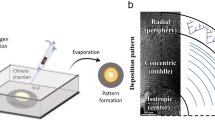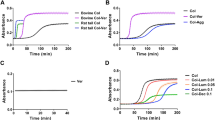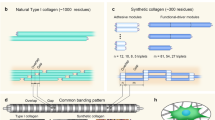Abstract
THE constituents of the extracellular matrix have a fundamental role in the structure and function of all tissues. A major insight into the composition of this matrix came with the discovery1–3 that interstitial collagen was not homogeneous, but rather composed of two species, termed Type I and Type III. Type I collagen (composed of two α1(I) chains and one α2 chain) usually forms densely packed fibrils (the cross-banded collagen commonly seen in electron micrographs). In comparison, Type III collagen (composed of three α1(III) chains) exists, in part, as reticulin, in which fine, randomly dispersed collagen fibrils are intimately associated with other connective tissue components3,4. Appreciation of the possible functional significance of the heterogeneity of the interstitial collagens has come from the analysis of the ratio of Type I to Type III collagen in different tissues in health and disease. Most pliable tissues (skin, intestine, blood vessels, lung) have a I : III ratio of 2–3 to 1, while rigid tissues (bone, tendon) contain only Type I collagen5,6. Studies of inflammation and wound healing have demonstrated that early granulation tissue (a material with little tensile strength) has a very low I : III ratio4,7, while mature scar (a stiff tissue) has a high I : III ratio8. In addition, disorders associated with a loss of tissue compliance (arterosclerosis9, pulmonary fibrosis10) are associated with a shift in the normal I : III ratio toward relatively more Type I collagen. Taken together, these findings suggest that the structure and function of tissues are intimately associated with the relative amounts of the interstitial collagens, with Type I tightly packed and tough and Type III loosely associated and pliable. If the relative amounts of collagens I and III are as important as this data suggests, the maintenance of normal interstitial tissues must be critically dependent on cells in the local environment rigidily maintaining their differentiated state with respect to the synthesis and degradation of these collagen types. We describe here a study designed to evaluate this hypothesis, using a model system to assess the ‘tightness’ of cellular control of the synthesis of collagens I and III by a population of similar cells (fibroblasts in culture) over approximately 20 replicative cycles.
This is a preview of subscription content, access via your institution
Access options
Subscribe to this journal
Receive 51 print issues and online access
$199.00 per year
only $3.90 per issue
Buy this article
- Purchase on Springer Link
- Instant access to full article PDF
Prices may be subject to local taxes which are calculated during checkout
Similar content being viewed by others
References
Chung, E. & Miller, E. J. Science 183, 1200–1201 (1974).
Epstein, E. H., Jr, J. biol. Chem. 249, 3225–3231 (1974).
Fietzek, P. P. & Kühn, K. Int. Rev. connec. Tissue Res. 7, 1–60 (1976).
Gay, S. et al. Klin. Wschr 53, 899–902 (1975).
Epstein, E. H., Jr & Munderloh, H. H. J. biol. Chem. 250, 9304–9312 (1975).
Miller, E. J. Clin. Orthop. Rel. Res. 92, 260–280 (1973).
Bailey, A. J., Sims, T. J., LeLous, M. & Bazin, S. Biochem. biophys. Res. Commun. 66, 1160–1165 (1975).
Shuttleworth, C. A., Forrest, L. & Jackson, D. S. Biochim. biophys. Acta 379, 207–216 (1975).
McCullagh, K. A. & Balian, G. Nature 258, 73–75 (1975).
Seyer, J. M., Hutcheson, E. T. & Kang, A. H. J. clin. Invest. 57, 1498–1507 (1976).
Hance, A. J., Bradley, K. & Crystal, R. G. J. clin. Invest. 57, 102–111 (1976).
Smith, J. R. & Hayflick, L. J. Cell Biol. 62, 48–53 (1974).
Gallop, P. M. & Paz, M. A. Adv. exp. Biol. 53, 329–338 (1975).
Mayne, R., Vail, M. S., Mayne, P. M. & Miller, E. J. Proc. natn. Acad. Sci. U.S.A. 73, 1674–1678 (1976).
Narayanan, A. S. & Page, R. C. J. biol. Chem. 251, 5464–5471 (1976).
Smith, B. D., Byers, P. H. & Martin, G. R. Proc. natn. Acad. Sci. U.S.A. 69, 3260–3262 (1972).
Bradley, K. H., McConnell-Breul, S. D. & Crystal, R. G. Proc. natn. Acad. Sci. U.S.A. 71, 2828–2832 (1974).
Scott, P. G. & Veis, A. Connec. Tissue Res. 4, 107–116 (1976).
Chung, E., Keele, E. M. & Miller, E. J. Biochemistry 131, 3459–3464 (1974).
Wrigley, C. W. J. Chromat. 36, 362–365 (1968).
Bours, J. Sci. Tools 20, 29–34 (1973).
Author information
Authors and Affiliations
Rights and permissions
About this article
Cite this article
HANCE, A., CRYSTAL, R. Rigid control of synthesis of collagen Types I and III by cells in culture. Nature 268, 152–154 (1977). https://doi.org/10.1038/268152a0
Received:
Accepted:
Issue Date:
DOI: https://doi.org/10.1038/268152a0
This article is cited by
-
Distinct phenotypes of cancer cells on tissue matrix gel
Breast Cancer Research (2020)
-
High cell density alters the ratio of type III to I collagen synthesis by fibroblasts
Nature (1979)
-
Cells, collagen and idiopathic pulmonary fibrosis
Lung (1978)
Comments
By submitting a comment you agree to abide by our Terms and Community Guidelines. If you find something abusive or that does not comply with our terms or guidelines please flag it as inappropriate.



